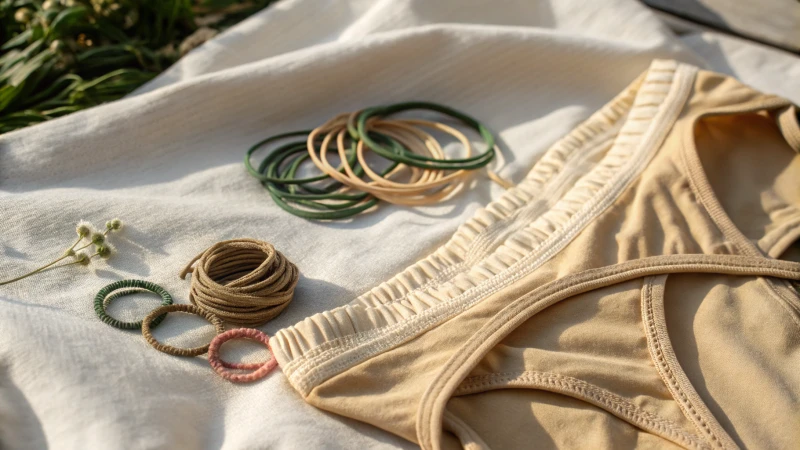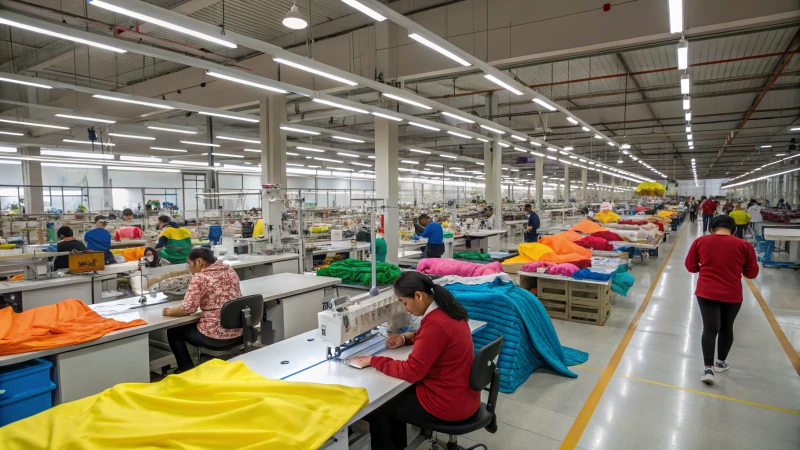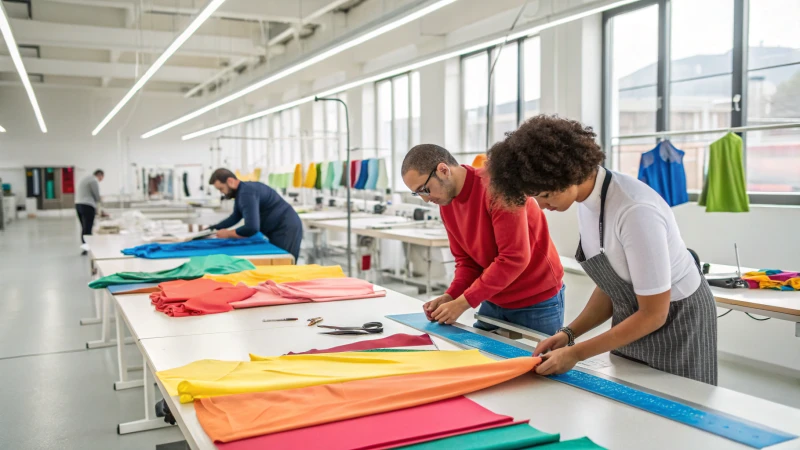
Sustainability now ranks very high in fashion. Biodegradable elastics are changing the underwear industry. Have you ever thought about how your choices affect the planet? I really have and it's surprisingly revealing!
Biodegradable elastics in underwear provide many benefits. They help reduce environmental pollution. Waste decreases. Consumer interest increases. These materials break down faster than traditional ones. They are a sustainable choice. They meet both ecological needs and comfort needs.
On my path to living more sustainably, I uncovered the magic of biodegradable elastics in underwear. Comfort matters, but choices also matter for our planet. These materials break down faster than usual options. They help cut down pollution and waste. This fact really brings peace of mind. Every pair I wear makes me feel part of a bigger cause. Contributing to both style and the environment feels rewarding. Let's explore the really amazing benefits these eco-friendly elastics offer us and the Earth.
Biodegradable elastics reduce environmental pollution in fashion.True
Using biodegradable elastics significantly lessens the harmful impact on the environment compared to traditional materials, promoting sustainability in the fashion industry.
Traditional elastics decompose faster than biodegradable ones.False
Contrary to biodegradable options, traditional elastics take much longer to decompose, contributing more to environmental waste and pollution.
How Do Biodegradable Elastics Work in Underwear?
Have you ever thought about the hidden heroes in your underwear? Biodegradable elastics are here to change the game. These elastics transform our beloved garments into eco-friendly choices. They create a positive impact on our planet. Let's explore this green revolution together!
Biodegradable elastics in underwear decay naturally as time passes. These elastics greatly reduce environmental impact. Traditional options do not offer similar benefits. They provide a lot of comfort. Sustainability is another advantage they bring. Biodegradable elastics fit well with circular fashion principles. Eco-conscious consumers choose them for this reason.

Understanding Biodegradable Elastics
Biodegradable elastics are made from materials that can decompose naturally, unlike traditional synthetic elastics that can take centuries to break down. These materials are designed to provide the same functionality as conventional elastics but with a significantly reduced environmental impact.
One common material used in biodegradable elastics is natural rubber, which is derived from the sap of rubber trees. Natural rubber is not only elastic and durable but also biodegradable, meaning it can return to the earth without leaving harmful residues. Another option is Tencel, made from sustainably sourced wood pulp, which also decomposes much more quickly than synthetic fibers.
The Environmental Impact
The production of biodegradable elastics contributes to a lower carbon footprint compared to synthetic options. This is primarily due to:
| Aspect | Biodegradable Elastics | Traditional Elastics |
|---|---|---|
| Production Emissions | Lower emissions | Higher emissions |
| Decomposition Time | Months to years | Centuries |
| Toxic Residue Post-Decomposition | None | Harmful residues |
By utilizing these materials, brands not only meet environmental regulations but also appeal to eco-conscious consumers who are increasingly prioritizing sustainability in their purchasing decisions.
Benefits of Biodegradable Elastics in Underwear
- Skin-Friendly: Biodegradable elastics often contain fewer chemicals than synthetic alternatives, making them gentler on the skin. This is particularly important in underwear, where comfort is paramount.
- Support for Circular Fashion: These materials align with the principles of circular fashion, promoting the idea that products can be designed for a lifecycle that includes eventual decomposition rather than landfill accumulation. Brands that adopt such practices can enhance their market reputation.
- Regulatory Advantages: As environmental regulations tighten, brands using biodegradable elastics may find it easier to comply with legal standards regarding waste and sustainability, thus avoiding penalties and enhancing their credibility.
- Consumer Attraction: By offering products that contribute to sustainability, brands can attract a growing demographic of eco-conscious consumers who prioritize green products in their buying habits.
Challenges in Implementation
Despite the benefits, there are challenges associated with using biodegradable elastics:
- Cost: Often, biodegradable materials are more expensive to produce than synthetic alternatives, which may impact pricing strategies.
- Availability: Sourcing high-quality biodegradable elastics can be a challenge as demand increases and manufacturers adapt.
- Performance: Ensuring that biodegradable elastics maintain performance standards (stretch, durability) comparable to traditional options can require additional research and development.
For brands looking to innovate and differentiate themselves in a competitive market, understanding these factors is crucial for successfully integrating biodegradable elastics into their product lines.
Biodegradable elastics decompose faster than traditional elastics.True
Biodegradable elastics can break down in months to years, unlike traditional options that take centuries, reducing environmental impact significantly.
Natural rubber is the only material used for biodegradable elastics.False
While natural rubber is a common material, Tencel and other options are also used for biodegradable elastics, enhancing their versatility.
What Are the Environmental Impacts of Traditional Elastics?
Ever thought about what is inside a simple elastic band or the waistband of your favorite shorts? Let's explore the often-ignored environmental costs of traditional elastics. These small items have a significant impact on our planet. They probably affect our lives too.
Traditional elastics often use materials like elastane. These materials create big environmental problems. They use up many resources. Production and disposal lead to pollution. Marine life suffers because of them.

The Production Process of Traditional Elastics
Traditional elastics, commonly made from synthetic materials like elastane, are produced through a chemical process that involves petroleum-based resources. This production method contributes significantly to environmental degradation.
- Resource Depletion: Extracting petroleum for production can lead to habitat destruction and biodiversity loss. Picture a forest full of life, turned into empty land just to create a material for our clothing.
- Energy Consumption: The manufacturing process is energy-intensive, often relying on fossil fuels, which contributes to greenhouse gas emissions. Each time I wear stretchy leggings, I now think about how much energy they used to make.
This cycle creates a ripple effect, affecting not only the immediate environment but also global ecosystems.
Environmental Pollution
During the production and disposal of traditional elastics, various pollutants are released:
| Pollution Type | Source | Impact |
|---|---|---|
| Air | Manufacturing emissions | Contributes to climate change |
| Water | Chemical runoff | Contaminates local water bodies |
| Soil | Waste disposal | Degrades land quality |
Synthetic elastics do not biodegrade effectively; they can persist in landfills for decades, releasing harmful chemicals into the soil and water. It's alarming to think our old clothes can leak toxins long after we stop wearing them.
Impact on Marine Life
Elastic materials often end up in oceans and waterways, leading to severe consequences for marine ecosystems:
- Microplastics: As they break down, traditional elastics contribute to microplastic pollution, which affects marine organisms.
- Ingestion by Wildlife: Many sea creatures mistake these materials for food, leading to internal injuries or death. It’s worrying to realize about 8 million tons of plastic enter oceans yearly, with elastics being a significant contributor. Learn more about marine pollution1.
Alternatives and Innovations
In response to the negative impacts of traditional elastics, several brands are exploring alternative materials:
- Biodegradable Elastics: New developments in biodegradable materials offer a promising solution. These elastics decompose naturally without leaving harmful residues. I feel hopeful when brands focus on sustainability. Explore sustainable options2.
- Recycled Materials: Some companies are innovating by using recycled plastics to create new elastic materials, reducing the need for virgin petroleum resources.
Consumer Awareness and Responsibility
As consumers become more aware of the environmental impacts of their choices, there is a growing demand for sustainable products. Key points include:
- Researching Brands: Look for brands that prioritize sustainable practices in their production processes.
- Supporting Circular Fashion: Engaging with brands that use biodegradable or recycled materials supports a circular economy approach.
Learning about traditional elastics changed how I shop and view fashion. Together, we really can choose wisely to protect our planet. Find tips on sustainable fashion3.
Traditional elastics contribute to significant environmental pollution.True
The production and disposal of traditional elastics release pollutants into air, water, and soil, causing environmental degradation.
Biodegradable elastics do not persist in landfills for decades.True
Unlike traditional elastics, biodegradable options decompose naturally without leaving harmful residues, reducing landfill impact.
How Can Biodegradable Elastics Enhance Comfort and Skin Health?
Have you ever thought about what touches your skin daily? I am really excited to talk about biodegradable elastics. These new materials probably improve comfort in clothing. They really help with skin health. Underwear and activewear benefit greatly from these elastics.
**Biodegradable elastics bring much comfort and are kind to the skin. They greatly lessen irritation, manage moisture well and bend more easily than usual synthetic materials. A softer feel against the skin gives them a really good edge for those wanting a cozy wear experience. They also respect the environment.
Understanding Biodegradable Elastics
Biodegradable elastics are a breath of fresh air for fabric lovers. Coming from natural origins, they break down easily when discarded. This fact makes choices less worrisome because there’s less guilt about adding waste to landfills.
Material Composition꞉ Biodegradable elastics feel much kinder on the skin. They are usually from natural rubber or polylactic acid (PLA). These materials probably cause less irritation, which really helps those suffering from rashes or discomfort from synthetic fabrics.
Moisture Control꞉ During exercise, synthetic fabrics often cling due to moisture. However, many biodegradable elastics excel in keeping skin dry and comfy. Natural fibers usually absorb moisture better than synthetics. That's a huge advantage!
Comfort Through Flexibility and Breathability
Flexibility in biodegradable elastics greatly adds to comfort. They stretch and fit the body without pressing or squeezing. It feels like a second skin.
Breathability꞉ These elastics let air flow, stopping overheating during hot days or intense exercise. Sweat and irritation have reduced for me since using these airy materials.
Softness Against Skin꞉ Their softness changed the game. They feel much nicer against the skin compared to synthetic ones. This soft touch is essential when wearing clothes all day long.
Long-Term Skin Health Benefits
Biodegradable elastics don’t just offer comfort. They are a wise choice for long-term skin health.
Reduction in Allergens꞉ Many of these materials are hypoallergenic, fitting perfectly for those prone to allergies or irritations. If curious, explore some hypoallergenic choices made for sensitive skin.
Less Chemical Exposure꞉ Regular elastics often contain strong chemicals that seep into the skin. Choosing biodegradable options reassures by reducing contact with such substances.
Conclusion of Insights
Opting for biodegradable elastics not only brings immediate comfort but fosters healthier skin in the future. As eco-awareness grows, these materials signify a major step in comfort and sustainability. Explore further into sustainable fabrics to discover more innovations that transform the industry positively.**

Discovering Biodegradable Elastics
When I found biodegradable elastics, I felt like I had found a true hidden gem in textiles. That was a moment of discovery! These materials do not follow just any trend. They really improve our daily comfort. They treat our planet with kindness. Let me take you on a journey to explore their benefits. I have learned personally how they probably transform our clothing experience.
Material Composition: Biodegradable elastics are often made from materials like natural rubber or polylactic acid (PLA), which are less likely to cause skin irritations compared to petroleum-based elastics. This is particularly beneficial for sensitive skin types that react poorly to synthetic materials.
Moisture Control: Many biodegradable elastics have better moisture-wicking properties, helping to keep skin dry. This can significantly reduce discomfort during wear, especially in active environments. A study on moisture management4 indicates that natural fibers often outperform synthetics in moisture absorption.
Comfort Through Flexibility and Breathability
Biodegradable elastics provide enhanced flexibility, which can lead to greater comfort during wear. The properties of these materials allow them to stretch and conform to the body without causing tightness or restriction.
- Breathability: These elastics promote airflow, which is crucial in preventing overheating and maintaining a comfortable body temperature. Products made with breathable materials can significantly reduce sweating and skin irritation.
- Softness Against Skin: Unlike synthetic elastics, biodegradable options often feel softer against the skin, enhancing the overall comfort experience. This softness can be a game-changer for individuals wearing garments for extended periods, such as underwear or activewear.
| Feature | Biodegradable Elastics | Traditional Elastics |
|---|---|---|
| Skin Irritation Risk | Lower | Higher |
| Moisture Wicking | Better | Moderate |
| Breathability | High | Moderate |
| Environmental Impact | Positive | Negative |
Long-Term Skin Health Benefits
Using biodegradable elastics can contribute positively to long-term skin health. Here's how:
- Reduction in Allergens: Many biodegradable materials are hypoallergenic, making them suitable for those prone to allergies and irritations. Explore hypoallergenic options5 that cater specifically to sensitive skin needs.
- Less Chemical Exposure: Traditional elastics often contain harsh chemicals used in their production, which can leach into the skin over time. By choosing biodegradable options, consumers can minimize their exposure to these potentially harmful substances.
Conclusion of Insights
Overall, opting for biodegradable elastics not only enhances immediate comfort but also fosters better skin health in the long run. With the growing demand for sustainable materials in clothing and personal care products, these elastics represent a significant advancement in both comfort and eco-friendliness.
For more insights on sustainable materials and their impact on health, consider looking into sustainable fabric innovations6 that continue to reshape the industry.
Biodegradable elastics reduce skin irritation compared to synthetics.True
Biodegradable elastics, made from natural materials, are less likely to irritate sensitive skin than traditional synthetic options, promoting overall skin health.
Moisture-wicking properties of biodegradable elastics are inferior.False
Contrary to this claim, biodegradable elastics actually outperform synthetic materials in moisture management, keeping skin dry and comfortable.
What Role Do Biodegradable Elastics Play in Sustainable Fashion Trends?
Have you ever wondered about the hidden threads that hold our clothes together and their effects on Earth? Biodegradable elastics play an important role in green fashion trends. These eco-friendly materials really help reduce harm to the environment.
Biodegradable elastics have a very important role in sustainable fashion. These materials reduce environmental pollution. They support circular fashion ideas. Consumers really want eco-friendly products.

The Environmental Impact of Biodegradable Elastics
I remember my first encounter with biodegradable materials. It was enlightening! Biodegradable elastics decompose quicker than traditional synthetic ones, significantly reducing environmental pollution.
Traditional elastics can linger in landfills for centuries. Eco-friendly alternatives, however, break down into harmless substances in just a few years. Imagine our clothes leaving only a tiny mark on earth. Biodegradable elastics could very well achieve this vision. I often reflect on how my small choices contribute to a healthier planet.
To learn more about the impact of biodegradable materials7 on the environment, consider exploring studies that showcase their benefits.
Supporting Circular Fashion Principles
I love biodegradable elastics for how they fit circular fashion principles. This method focuses on waste reduction and material reuse, creating a sustainable lifecycle for products.
| Aspect | Traditional Elastics | Biodegradable Elastics |
|---|---|---|
| Decomposition Time | 100+ years | 1-5 years |
| Environmental Impact | High | Low |
| Contribution to Waste | Significant | Minimal |
By incorporating these elastics into their products, brands can actively reduce their ecological footprint and appeal to eco-conscious consumers who prioritize sustainability in their purchasing decisions.
Consumer Demand and Market Trends
As a fashion enthusiast, I find the industry's shift exciting. Environmental awareness is reshaping trends. Demand for sustainable materials is rising rapidly. Biodegradable elastics fit perfectly into this green movement, appealing to conscious shoppers wanting to feel good about their purchases.
Many brands now proudly highlight biodegradable elastics in their messaging. It's refreshing to see genuine commitments to sustainability, not mere trend-following. This attracts customers and helps brands meet new sustainability-focused regulations. To better understand consumer trends in sustainable fashion, check out the latest research on eco-friendly fashion preferences8.
Innovations in Production and Material Science
Biodegradable elastics bring thrilling innovations! Advances in material science now allow elastics from organic sources with a lower carbon footprint than conventional synthetics.
Every time I learn about new sustainable technologies, I feel hopeful. This innovation benefits our planet and helps brands stand out in a crowded market. By adopting unique materials, they become leaders in sustainability. If you're interested in the latest innovations in sustainable materials9, exploring this field can provide valuable insights into future trends.
Regulatory Compliance and Brand Reputation
Regulations on environmental impact are becoming stricter. Brands adopting biodegradable elastics stay compliant while improving their reputation.
Brands using these practices avoid penalties and earn customer loyalty. Consumers like me value sustainability; seeing companies invest in our planet's future and connect meaningfully with their audience is inspiring. For more information on regulations impacting sustainable fashion, consider researching fashion industry compliance10 standards.
Biodegradable elastics decompose faster than traditional ones.True
Unlike synthetic elastics that take over 100 years to decompose, biodegradable elastics break down within 1-5 years, significantly reducing landfill waste.
Consumer demand for sustainable fashion is decreasing.False
Contrary to this claim, consumer awareness of environmental issues has led to a skyrocketing demand for sustainable materials in fashion.
Conclusion
Biodegradable elastics enhance underwear by reducing environmental pollution, improving comfort and skin health, and supporting sustainable fashion principles, making them a preferred choice for eco-conscious consumers.
Discover how traditional elastics affect the environment and learn about eco-friendly alternatives. ↩
Understand the pollution caused by synthetic materials in the fashion industry. ↩
Explore sustainable alternatives to traditional elastic materials in fashion. ↩
Learn how biodegradable elastics can improve your product offerings while enhancing comfort for users. This link provides valuable insights. ↩
Explore sustainable fabric innovations that can elevate your brand's product line. This resource is invaluable for eco-conscious brands. ↩
Discover strategies for integrating biodegradable materials into your designs effectively. This guide offers practical tips. ↩
Discover how biodegradable elastics are revolutionizing sustainable fashion and why they matter for eco-conscious consumers. ↩
Learn more about consumer preferences for sustainable materials and how they shape market trends. ↩
Explore the latest advancements in material science that are paving the way for eco-friendly innovations. ↩
Understand the regulatory landscape affecting sustainable practices in the fashion industry. ↩






